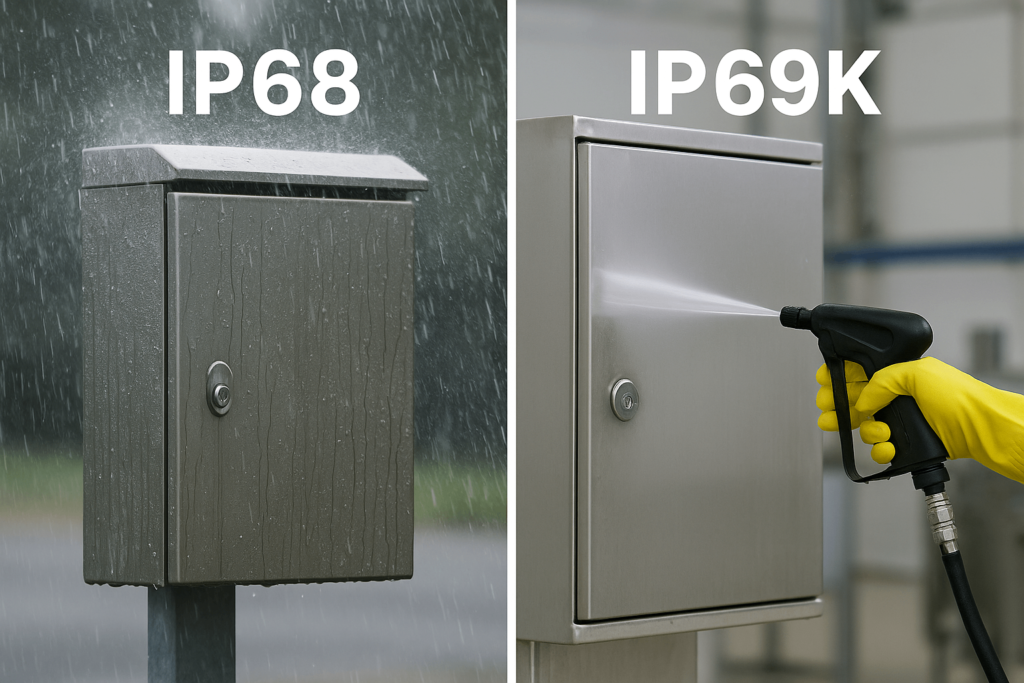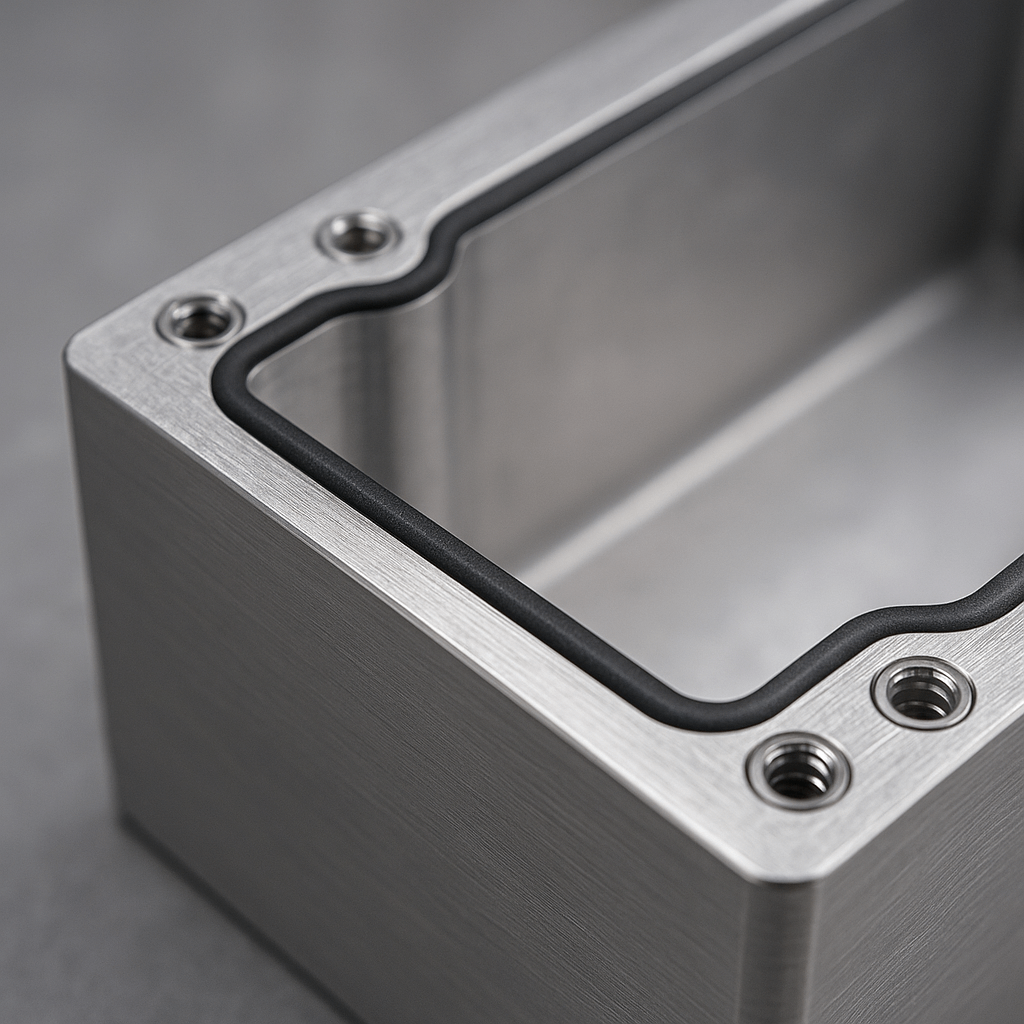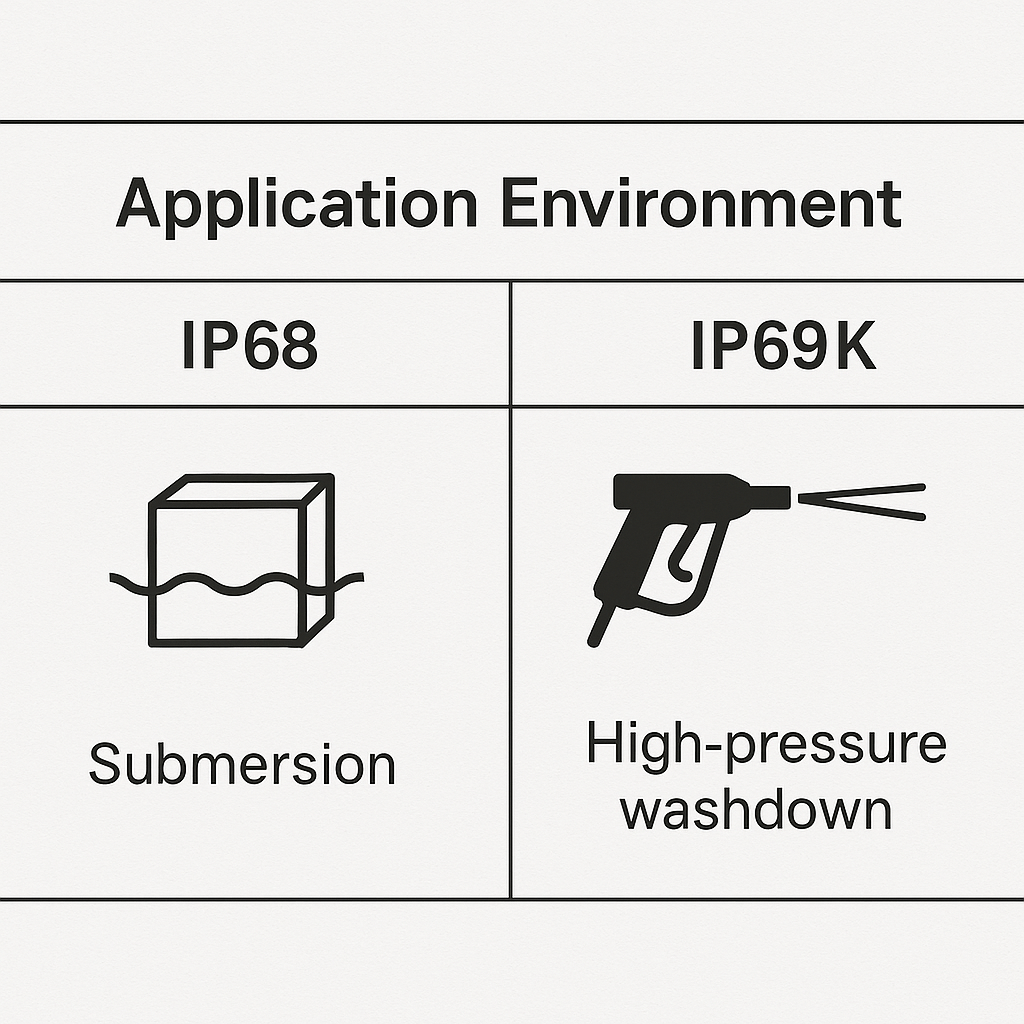In industrial procurement, vague terms like “waterproof” can lead to costly missteps—equipment failures, downtime, and reputational harm. When protection is critical, clarity matters.
That’s where the IP rating system steps in. Defined by IEC 60529, it offers a standardized way to evaluate an enclosure’s resistance to dust and water. But two of its highest ratings—IP68 and IP69K—are often misunderstood.
This guide unpacks their real-world differences. Whether you’re sourcing IP69K enclosures for food washdowns or IP68 cabinets for outdoor installations, you’ll learn how to specify the right protection—and avoid expensive failures.
The Core Misconception: Why IP69K Does NOT Automatically Supersede IP68
When comparing IP69K vs IP68, the most prevalent and dangerous assumption is the “Hierarchy Myth”—the belief that a higher number is inherently better. This is fundamentally incorrect.
A device certified for IP68 immersion is not guaranteed to pass an IP69K high-pressure jet test. Conversely, an IP69K-rated device is not certified for continuous submersion.

The Critical Physics: Static Pressure vs. Dynamic Impact
To frame this for an engineering mindset, consider the forces involved. An IP68-rated device is analogous to a submarine hull at depth—subjected to immense, but constant and uniformly distributed, static hydrostatic pressure.
An IP69K-rated device, however, is like a turbine blade being hit at point-blank range with a high-pressure steam jet—subjected to a violent, focused, dynamic impact force combined with extreme thermal energy.
This distinction—static vs. dynamic pressure—is the root of every design difference. A gasket designed for static compression can have its sealing lip physically lifted by the focused, high-velocity jet of an IP69K test. Specifying the wrong rating leads directly to premature, costly field failures.
If you’re evaluating enclosures for IP69K-rated equipment used in high-pressure cleaning environments, understanding this physical difference is mission-critical.
IP68: The Engineering of Endurance Under Static Load
The IP68 rating is critical for equipment where water immersion is a primary risk. It signifies that an enclosure is completely dust-tight (the ‘6’) and can withstand continuous immersion under conditions more severe than IP67.
IP68 is often the default requirement for customers looking for metal junction boxes for outdoor electrical installations, underground control panels, or marine-grade sensor housings where static water pressure dominates.
Decoding the "8": The Critical Importance of Manufacturer Specifications
Unlike lower IP levels, the standard for the digit ‘8’ is intentionally flexible. The IEC dictates that the specific depth and duration of immersion must be defined by the manufacturer. This places a burden on the procurement professional to scrutinize supplier datasheets.
For example:
The Apple iPhone 15 Pro is rated IP68, specified to withstand 6 meters for 30 minutes.
The Samsung Galaxy S24 Ultra is also IP68, but specified for 1.5 meters for 30 minutes.
Both are IP68 compliant, yet one is engineered for four times the pressure. In industrial procurement, this translates to verifying these specific parameters to mitigate risk.
The Science of the Static Seal: A Battle Against Material Fatigue
For an IP68-rated enclosure, the seal is static, compressed once at the factory. Its primary enemy is material fatigue over time, reflected in two key properties:
Compression Set: A high compression set value means the gasket loses its “memory,” creating a potential leak path.
Stress Relaxation: This describes the loss of sealing force over time. A good material will exhibit minimal relaxation to maintain a tight seal.
Enclosure construction matters. A rigid, high-quality metal housing ensures uniform gasket compression. A flimsy enclosure can warp, creating weak points in the seal. For example, IP68 stainless steel cabinets for outdoor telecom systems demand robust structural integrity to ensure long-term reliability in submerged or rain-prone environments.

IP69K: Engineered for Survival in High-Temp, High-Pressure Washdown Environments
IP69K is engineered for aggressive industrial washdowns, where hygiene is critical. It originated from DIN 40050-9 and is defined in ISO 20653, used for road vehicles and industrial equipment.
One common use case is sourcing IP69K-rated metal housings for food processing machines, where high-pressure steam cleaning is standard operating procedure.
Understanding the Test Protocol
The IP69K test simulates high-pressure cleaning with the following conditions:
Water Temperature: 80°C (176°F), introducing
thermal shockWater Pressure: 80–100 bar (1160–1450 PSI)
Proximity and Angles: A rotating device is sprayed at four angles from 10–15 cm
Material Science and Hygienic Design
Procurement managers must consider the following:
Material (304 vs. 316L Stainless Steel): 316L is preferred for aggressive environments due to superior corrosion resistance.
Surface Finish (Ra): A smoother surface (Ra < 0.8μm) resists bacterial adhesion and eases cleaning.
These factors are especially relevant for OEMs sourcing custom IP69K stainless enclosures for dairy or beverage factories, where both chemical resistance and cleanability are required.

EHEDG Compliance: Going Beyond IP69K
In food, beverage, and pharma sectors, IP69K is often paired with EHEDG standards for hygienic design:
Sloped Surfaces: At least a 30° slope to allow drainage
Crevice-Free Design: Continuous welds, no sharp corners
Hygienic Seals: FDA-grade silicone gaskets, often blue for visibility
Suppliers that integrate both IP and EHEDG requirements offer added value in regulated industries. For example, many cleanroom installations demand custom IP69K electrical boxes that meet both sanitary and functional benchmarks.
Insights from the Field: A Root Cause Analysis of "Water Damage"
High IP ratings are certifications under lab conditions, not guarantees of lifetime protection. Real-world variables degrade enclosures over time.
The Silent Killers of Seals
Gaskets are common failure points. Their degradation is accelerated by:
Environmental Attack: UV, chemicals, and temperature extremes
Thermal Shock: Rapid cooling creates vacuum effects that draw in moisture
Mechanical Stress: Impacts, over-torqued screws, or warped covers can compromise seals
Even the best rating fails if the seal is degraded or misapplied in the field. We’ve analyzed field failures in IP68 aluminum boxes installed in underground pump stations, where vibration-induced seal wear caused unexpected ingress.
A Specification & Procurement Framework: The Right IP Rating Checklist
Choosing between IP68 and IP69K requires aligning protection with real-world conditions. Use this checklist:
Exposure Type: Submersion (IP68) vs. Spray (IP69K)?
Force Type: Static pressure (IP68) vs. Dynamic jets (IP69K)?
Temperature: Room temp (IP68) vs. Steam (IP69K)?
Chemicals: Freshwater vs. Harsh cleaners (favor IP69K-compatible materials)?
Compliance Needs: General industry vs. Hygienic mandates (EHEDG)?
Cost Justification: Consider total cost of ownership, not just upfront price
If you’re currently comparing options like outdoor waterproof stainless steel cabinets with IP68 rating vs. washdown-proof IP69K enclosures for meat processing plants, this list can clarify which standard aligns better.

Quick-Fire FAQ
Is IP69K better than IP68?
No. Each addresses different threats: IP69K for washdowns, IP68 for immersion.
Is IP68 fully waterproof?
No device is truly waterproof. IP68 provides water resistance under specific conditions, which degrade over time.
Can an IP69K device be submerged in water?
Not necessarily. Submersion requires separate IPx8 testing.
Can I use a pressure washer on my IP68 device?
No. IP68 doesn’t protect against high-pressure jets.
What do NEMA and IK ratings mean?
NEMA: North American standard; broader than IP
IK: Resistance to physical impact (IEC 62262). Both ratings are independent from IP
If you’re working on a new equipment spec or planning an upgrade, our technical specialists can assist in determining which ingress protection level fits your intended environment best—whether it involves IP68 aluminum enclosures for harsh outdoor settings or IP69K-rated stainless cabinets for industrial sanitation zones.

